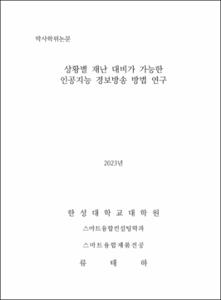상황별 재난 대비가 가능한 인공지능 경보방송 방법 연구
= A Study on AI Alert Broadcasting Method for Disaster Preparedness by Situation
- Appears in Collections:
- 스마트융합컨설팅학과 > 1. Thesis
- Files in This Item:
-
-
Download
 200000653605.pdf
기타 데이터 / 5.18 MB / Adobe PDF
200000653605.pdf
기타 데이터 / 5.18 MB / Adobe PDF
-
Items in Repository are protected by copyright, with all rights reserved, unless otherwise indicated.